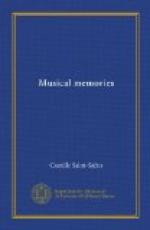There was a good deal of criticism of having the hunter, the reaper, and the shepherd sing a prayer together at the beginning of the third act. This was not considered theatrical; to-day that is a virtue.
There was a good deal of talk about L’Africanne, which had been looked for for a long time and which seemed to be almost legendary and mysterious; it still is for that matter. The subject of the opera was unknown. All that was known was that the author was trying to find an interpreter and could get none to his liking.
Then Marie Cruvelli, a German singer with an Italian training, appeared. With her beauty and prodigious voice she shone like a meteor in the theatrical firmament. Meyerbeer found his Africanne realized in her and at his request she was engaged at the Opera. Her engagement was made the occasion for a brilliant revival of Les Huguenots and Meyerbeer wrote new ballet music for it. To-day we have no idea of what Les Huguenots was then. Then the author went back to his Africanne and went to work again. He used to go to see the brilliant singer about it nearly every day, when she suddenly announced that she was going to leave the stage to become the Comtesse Vigier! Meyerbeer was discouraged and he threw his unfinished manuscript into a drawer where it stayed until Marie Sass had so developed her voice and talent that he made up his mind to entrust the role of Selika to her. He wanted Faure for the role of Nelusko and he was already at the Opera, so he had the management engage Naudin, the Italian tenor, as well.
But Scribe had died during the long period which had elapsed since the marriage of the Comtesse Vigier. Meyerbeer was now left to himself, and too much inclined to revisions of every kind as he was, re-made the piece to his fancy. When it was completed—it didn’t resemble anything and the author planned to finish it at the rehearsals.
As we know, Meyerbeer died suddenly. He realized that he was dying and as he knew how necessary his presence was for a performance of L’Africanne he forbade its appearance. But his prohibition was only verbal as he could no longer write. The public was impatiently awaiting L’Africanne, so they went ahead with it.
When Perrin and his nephew du Locle opened the package of manuscripts Meyerbeer had left, they were stupefied at finding no L’Africanne.
“Never mind,” said Perrin, “the public wants an Africanne and it shall have one.”
He summoned Fetis, Meyerbeer’s enthusiastic admirer, and the three, Fetis, Perrin and du Locle, managed to evolve the opera we know from the scraps the author had left in disorder. They did not accomplish this, however, without considerable difficulty, without some incoherences, numerous suppressions and even additions. Perrin was the inventor of the wonderful map on which Selika recognized Madagascar. They took the characters there in order to justify




